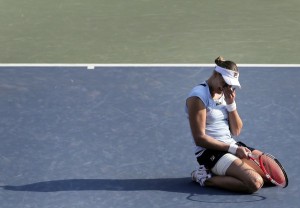By David Kane, Special for WorldTennisMagazine.com
Exciting up-and-comers come and go, but in tennis (as in life), you never forget your first love.
It would be impossible to explain why fans support the players they do. It could result from nationalistic pride, or even a chance encounter on the grounds of a tournament. No matter the meeting, the resulting emotional connection is usually indelible, and as long as that player has a racquet in his or her hand, the fan will be there, cheering them on to the last point. If the connection is to a ten-or-more Slam titlist, then “loving you is easy,” to quote Sarah McLachlan.
If the connection is to Nadia Petrova, then Avril Lavigne would call it “complicated.”
Despite her many gifts, including athletic genes and an effortlessly powerful serve, Nadia Petrova perfectly personifies the chaos that has often reigned on the WTA. While she may be one of the most talented players never to win a slam, very rarely is the body and mind of the tall Russian in proper alignment. During her long career, one or the other has failed her at crucial times, be it the upper leg injury that sent her packing from a French Open she was favored to win, or the many defeats she snatched from the jaws of victory. As recently as the US Open, both weaknesses appeared on display as a bandaged Petrova surrendered an early third set break to compatriot Maria Sharapova under the lights of Arthur Ashe Stadium. Combine these singular disappointments with a three year slump that has seen her fall from the top 20 and it would have been sensible to peg the 30 year old as a likely retirement casualty.
Leave it to Nadia to continue confounding expectations.
Earlier this year, her revolving door of coaches saw the arrival of Ricardo Sanchez. The man behind Jelena Jankovic’s rise to #1 and Caroline Wozniacki’s fall from the top spot brings his share of baggage and controversy. Such controversy was literally given a microphone when he let a few choice words slip this week during a coaching time-out. Love him or hate him, he appears to have gotten through to his charge in a way that few have in the last decade. In Tokyo, Petrova showed a new willingness to use her power and net prowess to end points and take the agency away from players like Sara Errani, Sam Stosur and Agnieszka Radwanska, three top 10 players who prefer to work points and create opportunities over long rallies. Against Petrova, they rarely had the chance.
A new physical strategy seems to coincide with a new mental mantra as well. Sanchez is overwhelmingly positive from the stands, and has morphed Petrova from a oft-described sourpuss into something of a fist pumper, a player more concerned with the progression of the match as opposed to perfect play. The player who survived a second set blowout by the world #3 to play positive tennis in the third was a stranger to all who watched her. She became even more unrecognizable as she pounced on the only break point of the set and punctuated a long rally on championship point with a ferocious swing volley.

Throughout the week, she played more than her fair share of long matches, and the longtime fan in me was ready to forgive her for letdowns that never came, but even a run to the final would have done little to convince me that this was more than the result of a lucky break; after all, she owes her place in the draw to the late withdrawal of doubles partner and fellow London bronze medalist Maria Kirilenko.
But as Petrova silenced Radwanska, a troublesome opponent when the Russian was at her best, and won her way to her highest ranking in two years, her on-court decision-making and positive attitude made the run seem like it could be more than a fluke, that at 30, her long-discussed promise could still be realized. Either way, results like this give hope to players and fans alike that, to quote the inimitable Mary Carillo, “it’s never too late to be what you might have been.”
